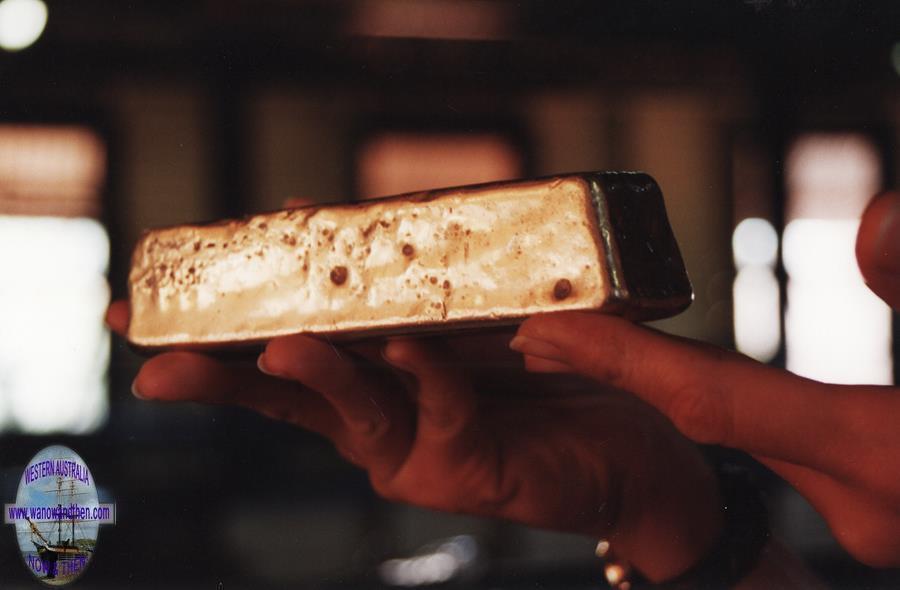|
|
|||
|
|
|
|
|
|
|
|||
GOLD DISCOVERIESWESTERN AUSTRALIA
|
|
|
|
|
|
WE NEED YOUR SUPPORT. |
|
|
|
|
From reading the historical literature it seems clear that the existence of gold in the state was known well before any of the official discoveries were announced. The information seems to have been deliberately suppressed by the government due to fears that people would abandon their usual employment and the state would be left without a labour force at a time when the continued survival of the colony was precarious in any case.
Robert Austin reported auriferous country in the 1850s but his reports were buried by the government. It was to be 40 years before his opinion was vindicated.
Our original information was that the first find of any gold reported in W.A. was near York in 1853 but we have since found that gold was sent to Adelaide for assessment from deposits of lead and copper from the Murchison area in 1848. Neither of these finds was of a commercial quantity.
The population of Western Australia was increased substantially due to these discoveries and from 1890 to 1900 it leapt from 48,000 to 180,000.
Huge amounts of gold were being found and early finds were of surface gold just sitting on the surface waiting to be picked up. The following figures indicate just one months production: Coolgardie 3760 oz, Halls Creek 115 oz, Pilbara 2654 oz, Dundas 54 oz, Murchison 8195 oz, Yilgarn 1517 oz, NE Coolgardie 128 oz, E Coolgardie 10795 oz, N Coolgardie 42 oz. A total of over 22,000 oz that would be worth over $11,000,000.00 US in today's figures.
It should be remembered that any official figures are only part of the story. Government duties meant that a lot of gold was smuggled out of the state and sold overseas or interstate to avoid paying the tax.
Early payable gold discoveries.
Halls Creek 1885
The men who found the gold.
Statewide gold yield.
Rewards paid by the Government for gold discoveries..
Staking a claim.
The procedure for staking a mining claim has changed little from the early days.
First any prospective miner had to obtain a Miner's Right and then (the hard part) find a bit of land that had not already been pegged and erect four posts (one at each corner of the claim).
The posts were to be no less than 3 feet tall and 4 inches in width. One of the posts had to have a plaque attached quoting the miners name, their Miner's Right number and the date of the claim. (This was called the datum post.) The miner, or a companion, then had to travel to the nearest Mining Warden to have the claim officially recognised.
Tall tales & true: Golden road!
Some years ago (quite a few in fact) road works were being conducted in Guildford after the railway line had been constructed and quartz was being used as the road base.
After some heavy rain the lumps of quartz started to come through the road surface and one day when a cart wheel struck and dislodged a piece of quartz, a sharp eyed youngster spotted the glint of gold.
He decided to try and find the origin of the quartz and after an extensive search discovered that it was supposed to have come from a quarry near Greenmount.
Even after careful examination over the years, no seam of gold has ever been found at the quarry and the origin of the gold laden quartz remains a mystery.
Convict Gold
C.C. Hunt was responsible for opening up a track to what would become the goldfields and he had with him a party of convicts who were used as labourers for sinking wells.
The story is told that the convicts found some gold and hid it with a view to escaping and returning later to pick up their find.
From what we have read to date it appears as though there was an escape attempt but the convicts were re-captured and nothing more was heard about the gold. The government at the time was not at all keen on any gold discoveries as this would have led to people abandoning their work in settled areas and there was a shortage of labour as it was.
Is there buried, somewhere along Hunt's Track, a stash of convict gold? I suppose we will never know.
Declared Gold Fields.
Ashburton, Coolgardie, Dundas, East Murchison, Gascoyne, Kimberley, Mount Magnet, Murchison, Peak Hill, Phillips River, Pilbara, Yalgoo, Yilgarn.
Gold production in modern times.
32,000 kgs annually Over 2.5 million kgs have been produced since gold was first discovered.
|
|
Become a supporter of this website for just $5 a month
|







